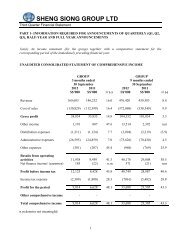FY 2011 Annual Report - Sheng Siong
FY 2011 Annual Report - Sheng Siong
FY 2011 Annual Report - Sheng Siong
You also want an ePaper? Increase the reach of your titles
YUMPU automatically turns print PDFs into web optimized ePapers that Google loves.
54 <strong>Sheng</strong> <strong>Siong</strong> <strong>Annual</strong> <strong>Report</strong> <strong>2011</strong><br />
Notes to the Financial Statements<br />
4 Significant accounting policies (Continued)<br />
4.7 Impairment (Continued)<br />
Non-derivative financial assets (Continued)<br />
Loans and receivables (Continued)<br />
An impairment loss in respect of a financial asset measured at amortised cost is calculated as the difference<br />
between its carrying amount and the present value of the estimated future cash flows discounted at the asset’s<br />
original effective interest rate. Losses are recognised in profit or loss and reflected in an allowance account<br />
against loans and receivables. When a subsequent event (e.g. repayment by a debtor) causes the amount of<br />
impairment loss to decrease, the decrease in impairment loss is reversed through profit or loss.<br />
Non-financial assets<br />
The carrying amounts of the Group’s non-financial assets, other than inventories are reviewed at each reporting<br />
date to determine whether there is any indication of impairment. If any such indication exists, then the asset’s<br />
recoverable amount is estimated. An impairment loss is recognised if the carrying amount of an asset or its<br />
related cash-generating unit (CGU) exceeds its estimated recoverable amount.<br />
The recoverable amount of an asset or CGU is the greater of its value in use and its fair value less costs to sell.<br />
In assessing value in use, the estimated future cash flows are discounted to their present value using a pre-tax<br />
discount rate that reflects current market assessments of the time value of money and the risks specific to the<br />
asset or CGU. For the purpose of impairment testing, assets that cannot be tested individually are grouped<br />
together into the smallest group of assets that generates cash inflows from continuing use that are largely<br />
independent of the cash inflows of other assets or CGU.<br />
Impairment losses are recognised in profit or loss.<br />
Impairment losses recognised in prior periods are assessed at each reporting date for any indications that<br />
the loss has decreased or no longer exists. An impairment loss is reversed if there has been a change in the<br />
estimates used to determine the recoverable amount. An impairment loss is reversed only to the extent that<br />
the asset’s carrying amount does not exceed the carrying amount that would have been determined, net of<br />
depreciation or amortisation, if no impairment loss had been recognised.<br />
4.8 Non-current assets held for sale<br />
Non-current assets that are expected to be recovered primarily through sale or distribution rather than through<br />
continuing use are classified as held for sale or distribution. Immediately before classification as held for sale<br />
or distribution, the assets are remeasured in accordance with the Group’s accounting policies. Thereafter the<br />
assets are generally measured at the lower of their carrying amount and fair value less costs to sell. Impairment<br />
losses on initial classification as held for sale or distribution and subsequent gains or losses on remeasurement<br />
are recognised in profit and loss. Gains are not recognised in excess of any cumulative impairment loss.<br />
Intangible assets and property, plant and equipment once classified as held for sale or distribution are not<br />
amortised or depreciated.



